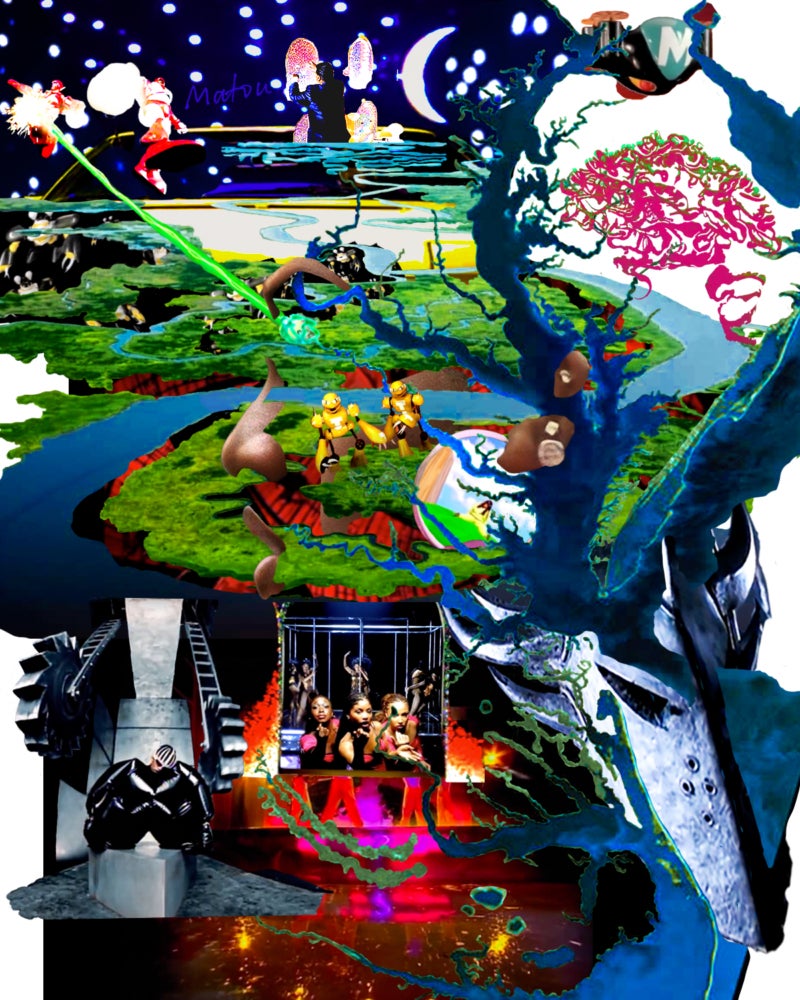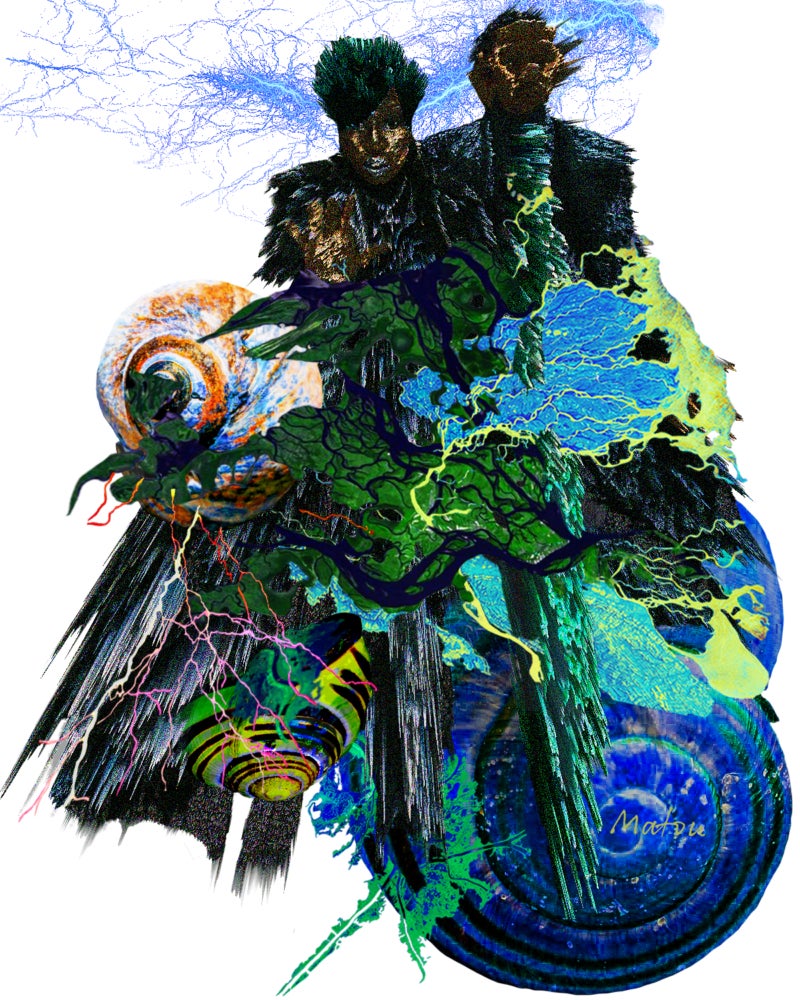Like the acacia, the music of Virginia is polyphyletic by nature; limitless in both ancestry and progeny, Virginia is home to the most idiosyncratic experimentations in rhythm and rhyme. The sounds of the Northeast, South, and the Midwest collide to form its fractal, coastal sound.
July 25th, 1997 marks a key evolutionary event in audiovisual history: Missy “Misdemeanor” Elliott—in cosmic collaboration with her fellow, budding inventor, Timothy “Timbaland” Mosley—created one of the most (re)generative works in music: Supa Dupa Fly. In a matter of only two weeks, Missy and Timbaland released this metamorphic catalyst into the landscapes of Hip-Hop and R&B, forging the two into a new, opaque fusion. Supa Dupa Fly not only affirmed Missy Elliott as an aesthetic force from the future, but also opened new “sidereal paths of space”[1] in the world of Black audio-visuality.
Missy and Timbaland began as budding epiphytes of Hampton Roads, a.k.a. the #757. Their convergence was kismet; Missy’s blessings in melody, combined with Timbaland’s gifts in rhythm, formed new elements in the periodic table of Black music. Descendants of New Jack Swing—pioneered by Teddy Riley, who harvested this sound in Virginia Beach—Missy and Timbaland fused intentions and began an odyssey of sonic reinvention. Building on the blues continuum[2] of Black music(s) before them, they began to regenerate the genres: Timbaland as Rhythm, and Missy, the Blues. Together, they collaged beloved rhythms and melodies from the worlds of Jazz, Soul and R&B. This vast constellation of samples include: Ann Peebles’ classic “I Can’t Stand the Rain”; “New World Symphony” by Earth, Wind and Fire; “Ready or Not Here I Come” by The Delfonics; Aaliyah’s “One in A Million”; the Puff Daddy Mix of “Love No Limit” by Mary J. Blige; “Do the Funky Chicken” by Rufus Thomas; “Check Me Out” by Eddie Floyd; and the ever-dynamic “Square Biz” by Teena Marie.

In addition to these R&B treasures, Missy and Timbaland sourced rhythms and melodies not only across genres, but regions as well, a practice they would utilize to continue to forge the next sounds in their journey. Of the most notable interpolations is their metamorphosis of the 1982 Reggae hit, “Pass The Dutchie” by Musical Youth into “Pass Da Blunt”. The signature interlude, “Bite Our Style”, is another staggering reinvention on the LP, which sampled the London funk/acid jazz band, Jamiroquai. These tracks embody Missy and Timbaland’s powers in refashioning; they took root in their idiosyncrasy and burgeoned this exquisite magnum opus, embodied by sixteen sonic testaments to the originality and irreplaceability of their style.
Although Supa Dupa Fly was Missy’s debut album as a solo artist, it was certainly not the first showcase of her genius. By 1997, Missy had lent her talents to no shortage of artists, transmuting her melodic ingenuity into the works of the most notable players in Hip-Hop and R&B; this included Aaliyah, Jodeci, 702, Puff Daddy and the Family, Mary J. Blige, Busta Rhymes, Ginuwine, SWV, and of course, Timbaland and Magoo. Many of them became stars in the Supa Dupa Fly galaxy, joined by new, fresh collaborators such as Da Brat, Space, and Nicole Wray. Missy’s vision—as potent as her inventiveness—was infinite enough to hold a constellation of superstars, all while still comfortably existing as her world. Missy’s craft moves beyond the limits of the One[3] into the abundance of Landscape.[4]
This invocation of landscape grows off the work of Édouard Glissant, the legendary poet of Martinique. In his work L’intention Poétique (Poetic Intention, 1969), Glissant stages a world-rendering discussion of aesthetics, politics, and literature, rooted in an ethic of biodiverse, planetary poetics. Poetic intention, a mode of both invention and relation that allows us to realize the world(s) we desire, is the (im)pulse that animates the premise of “landscape.” Motivated by the urgency of the poem, Glissant describes the necessity of poetic intention through both figurative and literal ecology. Furthermore, he details the exigency of landscape in providing a sense of nature for those “cut” from their roots:
“The significance (‘history’) of landscape or of nature is the revealed clarity of the process by which a community cut from its ties or its roots (And perhaps even, to begin with, from all possibility of rootedness), comes gradually to suffer the landscape, earn its Nature, know its country…Here then (by force of foothold) I feel the earth under my feet: I grow back immediately in yesterday, I feel around for the depths of irremediable time, I sand up oblivion and hurtle down the year, I reconquer my memory and grant value to my inspirations: such is stirring the earth and planting one’s tree”.[5]
Both the discipline and creativity that Missy invests in her craft are sheer acts of poetic intention, through which she actualized new landscapes of sound, visuality, and being. In its limitless profusions, Supa Dupa Fly generates the conditions for “the relational embodied in the world”.[6] The grounds for landscape blossom beyond the whims of any singular individual or aesthetic; it invokes a full ecosystem, an interdependent ecology that engulfs the assertion of any individual’s “star”-dom above the rest. Avulsing from the archetype of the western individual artist, Supa Dupa Fly refracts our gaze toward new scales of “Planeterization”[7], grounded in the totality of relation.

To fully appreciate Missy Elliot’s legacy, we should grasp Missy as the landscape, along with the limitlessness that weathers it: not only as Supa Dupa Fly, but as “The Rain” herself. She need not be concerned with rapping above or against others, as it’s clear her style is One in a Million.[8]. She does not eclipse these tracks as their “master”, nor does she “murder” the beats, and finds no need for the phallic sensibilities employed by many MCs. Instead, Missy hits us with “da Hee”, the ineffable greatness of Misdemeanor that exceeds all language. Inventing not only at the level of the word, but at heart of sound, Missy Elliot is the track, both in and of it; what results is a work in which the artist and the album congeal to form a landscape beyond herself.
Missy Elliott’s genius is forever stellated[9] in the oeuvres of hip-hop and R&B. As a singer, songwriter, producer, and MC – simultaneously coordinating musicality, lyricism, audiovisuality, movement, and performance—she has moved mountains to animate the Supa-Dupa-Verse in which so many find inspiration and belonging today. Supa Dupa Fly invites us into fantastic wonder The Misdemeanor Ecology, empowered by the poetic intention of Missy Elliott herself. Feeling the Virginia earth underneath her feet, she brings us together through the spirit of landscape, and the spirit of relation.
Thank you, Missy! For The Rain and Friendly Skies!
[1] Édouard Glissant, Poetic Intention, translated by Nathanaël and Anne Malena, (Brooklyn: Nightboat Books, 2018), 10.
[2] Leroi Jones, “The Blues Continuum,” in Blues People: Negro Music in White America, (Perennial, New York, NY, 2002).
[3] Glissant, Poetic Intention.
[4] Ibid.
[5] Glissant, 182.
[6] Glissant, 13.
[7] Glissant, 22.
[8] Interpolated from the title of the seminal Aaliyah track, “One in a Million”, written by Missy Elliott.
[9] Glissant, 29.




